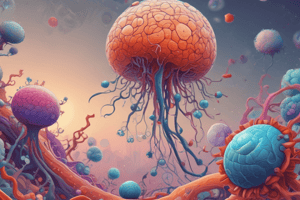Podcast
Questions and Answers
What is the primary function of the cell membrane?
What is the primary function of the cell membrane?
- To synthesize proteins
- To regulate what enters and leaves the cell (correct)
- To generate energy for the cell
- To provide support and maintain cell shape
What is the site of protein synthesis in the cell?
What is the site of protein synthesis in the cell?
- Cytoskeleton
- Mitochondria
- Endoplasmic Reticulum
- Ribosomes (correct)
What is the function of lysosomes in the cell?
What is the function of lysosomes in the cell?
- To synthesize proteins
- To regulate what enters and leaves the cell
- To generate energy for the cell
- To digest and recycle cellular waste (correct)
What is the function of the cytoskeleton in the cell?
What is the function of the cytoskeleton in the cell?
What is the function of the nucleus in the cell?
What is the function of the nucleus in the cell?
What is the function of the mitochondria in the cell?
What is the function of the mitochondria in the cell?
Flashcards are hidden until you start studying
Study Notes
Cell Structure and Function
Cell Membrane
- Semi-permeable membrane that surrounds the cell
- Composed of phospholipid bilayer with embedded proteins
- Regulates what enters and leaves the cell
Cell Wall
- Rigid layer outside the cell membrane in plants, fungi, and some bacteria
- Provides support, protection, and maintains cell shape
Cytoplasm
- Jelly-like substance inside the cell membrane
- Site of many cellular activities, including metabolism and protein synthesis
Nucleus
- Control center of the cell where DNA is stored
- Surrounded by a double membrane called the nuclear envelope
Mitochondria
- Powerhouses of the cell, responsible for generating energy through cellular respiration
- Have their own DNA and can reproduce independently
Endoplasmic Reticulum (ER)
- Network of membranous tubules and cisternae
- Involved in protein synthesis, folding, and transport
Ribosomes
- Small organelles found throughout the cytoplasm
- Site of protein synthesis
Lysosomes
- Membrane-bound sacs containing digestive enzymes
- Responsible for cellular digestion and recycling of cellular waste
Cytoskeleton
- Network of filaments that provides structural support and shape to the cell
- Involved in cell division, movement, and signaling
Cell Junctions
- Specialized structures that connect cells and allow for communication and exchange of molecules
- Types: tight junctions, desmosomes, and gap junctions
Cell Structure and Function
Cell Membrane
- Acts as a semi-permeable barrier, controlling what enters and leaves the cell
- Composed of a phospholipid bilayer with embedded proteins, allowing for selective permeability
- Regulates the movement of substances across the cell membrane
Cell Wall
- Provides structural support, protection, and maintains cell shape in plants, fungi, and some bacteria
- Rigid layer consisting of cellulose, chitin, or peptidoglycan, depending on the organism
Cytoplasm
- Jelly-like substance inside the cell membrane, where many metabolic processes occur
- Site of glycolysis, citric acid cycle, and fatty acid synthesis
- Supports cellular activities, such as protein synthesis and cell division
Nucleus
- Control center of the cell, containing most of the cell's genetic material (DNA)
- Surrounded by a double membrane called the nuclear envelope, which regulates the movement of molecules
Mitochondria
- Responsible for generating energy for the cell through cellular respiration (aerobic and anaerobic)
- Have their own DNA, known as mtDNA, and can reproduce independently
- Found in both eukaryotic and prokaryotic cells
Endoplasmic Reticulum (ER)
- Involved in protein synthesis, folding, and transport to the Golgi apparatus
- Rough ER has ribosomes attached, while smooth ER lacks ribosomes
- Plays a role in lipid synthesis and detoxification
Ribosomes
- Site of protein synthesis, where mRNA is translated into amino acid chains
- Found throughout the cytoplasm, either freely floating or attached to the ER
- Consists of two subunits: a large subunit and a small subunit
Lysosomes
- Contain digestive enzymes, responsible for breaking down and recycling cellular waste
- Membrane-bound sacs that fuse with vesicles and autophagosomes to digest cellular debris
- Involved in cellular defense against foreign substances and pathogens
Cytoskeleton
- Provides structural support, shape, and mechanical resistance to the cell
- Composed of three main components: microtubules, microfilaments, and intermediate filaments
- Involved in cell division, movement, and signaling
Cell Junctions
- Specialized structures that connect cells, allowing for communication and exchange of molecules
- Types include tight junctions, desmosomes, and gap junctions
- Play a crucial role in maintaining tissue structure and function
Studying That Suits You
Use AI to generate personalized quizzes and flashcards to suit your learning preferences.




